 |
 |
|
 |
 |
Japan: Miranda: 1955-1976:
Orion Camera Co. was the first Japanese company to launch a pentaprism slr. (Tokiwa Seiki had presented a penta mirror slr four months earlier.) Orion Seiki was founded in 1947, first making adapters for other brands, then Supreme lenses, Mirax housings
and Focabell bellows. But they were looking to Europe, especially inspired by the Exacta cameras, and produced a PP SLR prototype in 1953, carrying the name Orion Phoenix. Because a West-German company owned the rights to the Phoenix name, they had to rename
it before starting production. Under the name Orion Camera Co. they introduced their Miranda T model in 1955. One year later the company name was changed to Miranda Camera Co. after their first model. Miranda was a sensation in Japan during the first
years. Still, they were not financially strong. Their economic base came from their distributor in Japan, who raised the necessary funds to help the promising constructors as they were promoting the Phoenix in 1953. But in 1959 this distributor left Miranda,
with the dramatic result that Miranda was not distributed in Japan for four years! The american distributor, Allied Impex Corporation, aka AiC, who already owned Mirandas close partner Soligor, gradually took over the control of Miranda. In 1963, Miranda was
back on the Japanese market.
The first series: 1955-1959:
(1953: Prototype Orion Phoenix) 1955: Orion Camera Co. Miranda T 1956: Miranda Camera Co. Miranda T 1957: "
Miranda T II 1959: " Miranda S 1959:
" Miranda ST
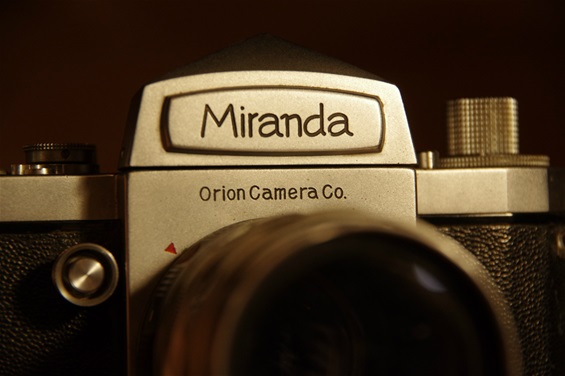 The Pioneer of Japanese PP SLRs: The Orion Camera Co. mod. T.
Not many Orion cameras were produced before company name was changed to Miranda in '56, so this is rare. The serial number is very low. The first series wore the model names T, T II, S and ST. They all had knob winders and rewinders, and had more or less the same layout. The later ones had more black on the knobs and on the prism, though. As almost all Mirandas came with interchangeable finder, one could order an additional waist level finder, but only the S model was originally delivered with one. The S was an economy model produced for the american market. All cameras from the first series were delivered with 44 mm screw mount lenses. The T was produced from '55 till '57.
Size: 148x95x43mm. Weight: 638g. Sn: 554845.
The Pioneer of Japanese PP SLRs: The Orion Camera Co. mod. T.
Not many Orion cameras were produced before company name was changed to Miranda in '56, so this is rare. The serial number is very low. The first series wore the model names T, T II, S and ST. They all had knob winders and rewinders, and had more or less the same layout. The later ones had more black on the knobs and on the prism, though. As almost all Mirandas came with interchangeable finder, one could order an additional waist level finder, but only the S model was originally delivered with one. The S was an economy model produced for the american market. All cameras from the first series were delivered with 44 mm screw mount lenses. The T was produced from '55 till '57.
Size: 148x95x43mm. Weight: 638g. Sn: 554845.
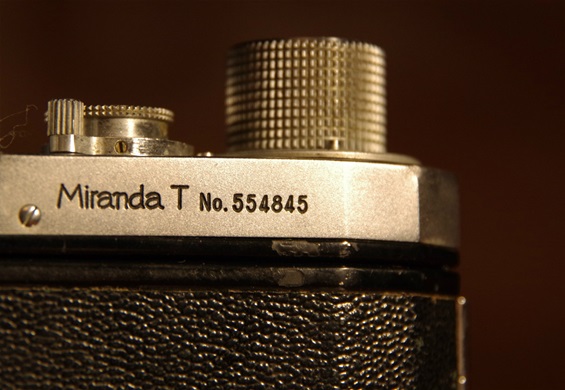 The T model controls were all silver. The T II, S and ST had black parts on shutter dial, winder and rewinder, plus black inserts on prism, as was typical on all later prisms.
The T model controls were all silver. The T II, S and ST had black parts on shutter dial, winder and rewinder, plus black inserts on prism, as was typical on all later prisms.
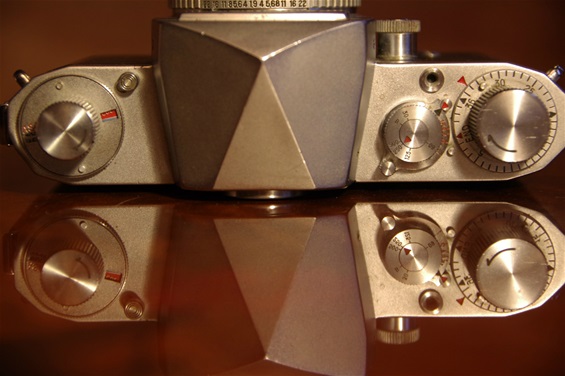 A dent at the left side, but otherwise in nice condition. And working!
A dent at the left side, but otherwise in nice condition. And working!
 Orion made lenses before they made cameras. This Supreme 105/2,8 lens was made for the Focabell bellow, but attached to the Orion T via a Spiratone adapter. Sn. 561610.
Orion made lenses before they made cameras. This Supreme 105/2,8 lens was made for the Focabell bellow, but attached to the Orion T via a Spiratone adapter. Sn. 561610.
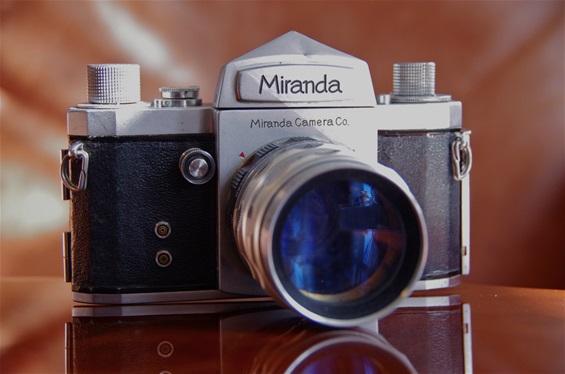 Here is the 1956 version with the new company name, Miranda.
Sn. 556291. There is also a Miranda T numbered 557253.
Here is the 1956 version with the new company name, Miranda.
Sn. 556291. There is also a Miranda T numbered 557253.
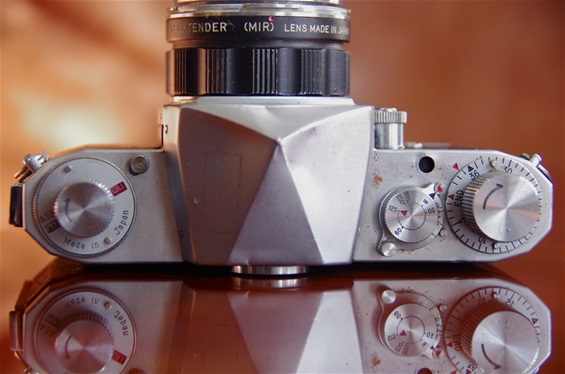 The prism top on many elder Mirandas have very visible dents, as if they were made of thinner metal than usual. However, a reader tells me they were not. (October '19) This sample also misses the threads for external shutter release cable, only a black hole is left. But mechanically fully working!
The prism top on many elder Mirandas have very visible dents, as if they were made of thinner metal than usual. However, a reader tells me they were not. (October '19) This sample also misses the threads for external shutter release cable, only a black hole is left. But mechanically fully working!
The second series: 1957-1962:
1957: Miranda Camera Co. Miranda A 1959: " Miranda B 1959:
" Miranda C 1960: " Miranda D 1961:
" Miranda DR 1962: MIRANDA CAMERA CO. MIRANDA DR (factory and brand name in capital letters)
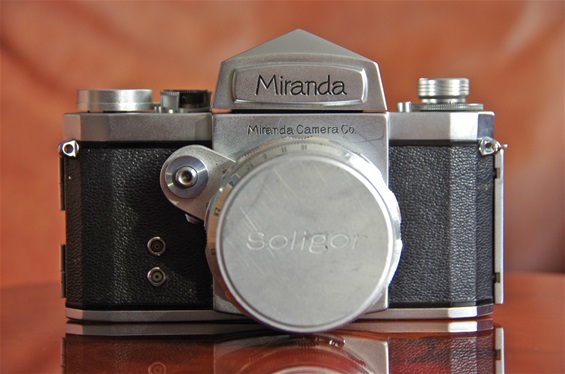 The Miranda A from 1957 was the first Miranda with a winder arm and rewind crank instead of the earlier knobs. The A also introduced the PAD lenses, Pressure Activated Diaphragm. Sn. 572012 means the first A was produced in 1957.
The Miranda A from 1957 was the first Miranda with a winder arm and rewind crank instead of the earlier knobs. The A also introduced the PAD lenses, Pressure Activated Diaphragm. Sn. 572012 means the first A was produced in 1957.
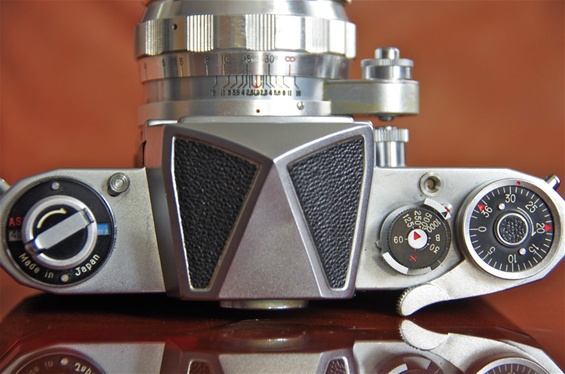 This is 1957 and Miranda A features the foldable rewind crank, just like Pentax just introduced to PP SLRs. A good camera.
This is 1957 and Miranda A features the foldable rewind crank, just like Pentax just introduced to PP SLRs. A good camera.
 The Miranda C from 1959 was the third camera in the second series, following the A and B. The B introduced the very important Instant Return Mirror (IRM) in a Miranda, some ten years after the Italian Rectaflex and two years after Pentax. Still, Miranda was as early as Minolta, Nikon and Canon, and before all German brands. The C added selftimer.
Size: 148x95x43mm. Weight: 678g. Sn: 603374.
By now, it seems that Miranda has left the code system of the two first digits in the serial number pointing at the first year of production of that specific model.
The Miranda C from 1959 was the third camera in the second series, following the A and B. The B introduced the very important Instant Return Mirror (IRM) in a Miranda, some ten years after the Italian Rectaflex and two years after Pentax. Still, Miranda was as early as Minolta, Nikon and Canon, and before all German brands. The C added selftimer.
Size: 148x95x43mm. Weight: 678g. Sn: 603374.
By now, it seems that Miranda has left the code system of the two first digits in the serial number pointing at the first year of production of that specific model.
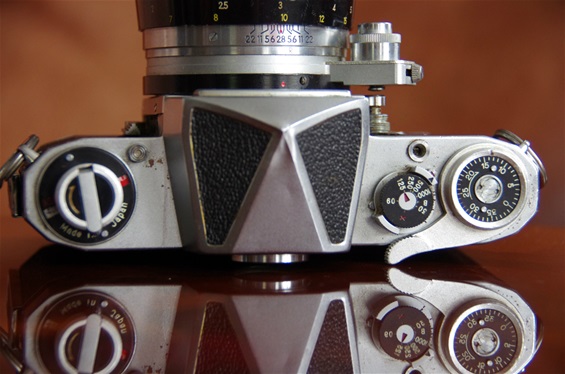 Almost identical to the A of 1957.
Almost identical to the A of 1957.
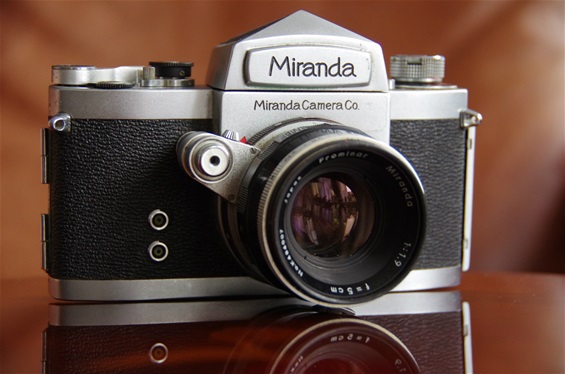 The D model from 1960. Around 1960 Miranda was a very popular brand worldwide and their sales probably at a time rose to a second place, still well behind Asahi Pentax. But again, without clear statistics, this is only the opinion of one source.
Size: 152x95x43mm. Weight: 636 g. Sn: 630640.
The D model from 1960. Around 1960 Miranda was a very popular brand worldwide and their sales probably at a time rose to a second place, still well behind Asahi Pentax. But again, without clear statistics, this is only the opinion of one source.
Size: 152x95x43mm. Weight: 636 g. Sn: 630640.
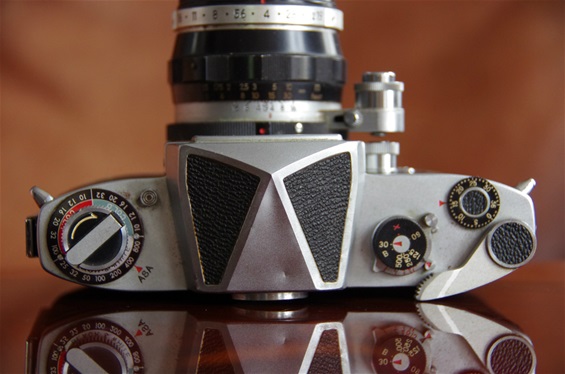 The D model has got a new winder arm, and the counter is placed seperately in front. Some change in details on shutter dial and rewinder. Shutter dial and counter is still revolving during winding and exposure.
The D model has got a new winder arm, and the counter is placed seperately in front. Some change in details on shutter dial and rewinder. Shutter dial and counter is still revolving during winding and exposure.
The Automex series: 1960-1965:
1960: Miranda Camera Co. Miranda automex I 1962: MIRANDA CAMERA CO. MIRANDA automex II 1965: MIRANDA CAMERA CO: MIRANDA automex III
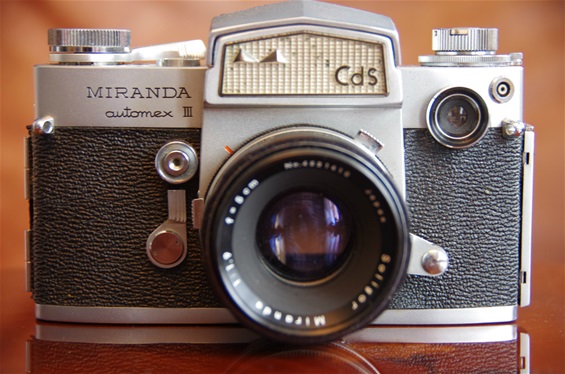 The Automex series, starting in 1960, featured a kind of light metering. The I and II models had a traditional selenium cell mounted in front of the prism, while the final model, III, as shown here and produced from '65, introduced the CdS cell in an eye mounted on the front wall under the rewind crank.
Sn: 624977.
The Automex series, starting in 1960, featured a kind of light metering. The I and II models had a traditional selenium cell mounted in front of the prism, while the final model, III, as shown here and produced from '65, introduced the CdS cell in an eye mounted on the front wall under the rewind crank.
Sn: 624977.
 New on the Automex was the prism with a fixed front plate, also to be used on the coming Sensorex. Shuttertime dial was moved to the top of the winder, and close to the winder was a window showing if the winder was cocked.
New on the Automex was the prism with a fixed front plate, also to be used on the coming Sensorex. Shuttertime dial was moved to the top of the winder, and close to the winder was a window showing if the winder was cocked.
Like the Minolta SR 7 of 1962, this Automex of '65 also had a CdS meter, but readable in the viewfinder.
The F/G series: 1963-1968:
1963: MIRANDA F and FB 1964: MIRANDA FM and FBM 1965: MIRANDA G 1967: MIRANDA GT 1967: MIRANDA Fv 1968: MIRANDA FvT
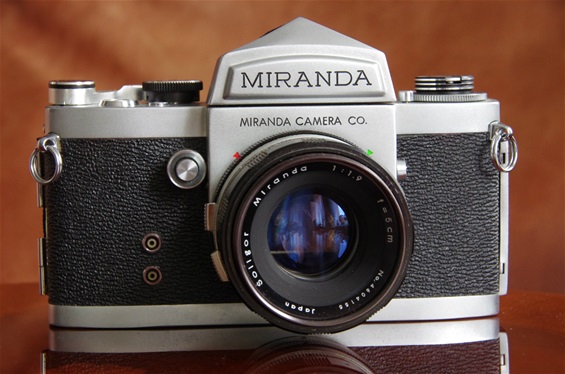 The F from 1963 featured some news: the shutter dial and counter dial no more rotated during winding and exposure. The PAD lens semi automatic system, inherited from Exakta and very modern at its time, was abandoned and the automatic diaphragm was put into the camera, like most others had already done. Size: 152x94x43mm. Weight: 640 g. Sn: 681495.
The F from 1963 featured some news: the shutter dial and counter dial no more rotated during winding and exposure. The PAD lens semi automatic system, inherited from Exakta and very modern at its time, was abandoned and the automatic diaphragm was put into the camera, like most others had already done. Size: 152x94x43mm. Weight: 640 g. Sn: 681495.
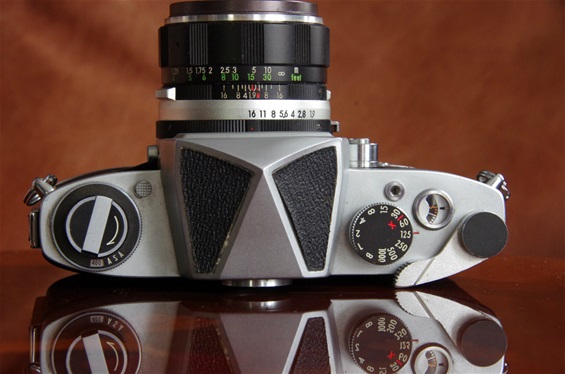 Glass covered counter, non revolving shutter dial, lower and redesigned rewinder.
Glass covered counter, non revolving shutter dial, lower and redesigned rewinder.
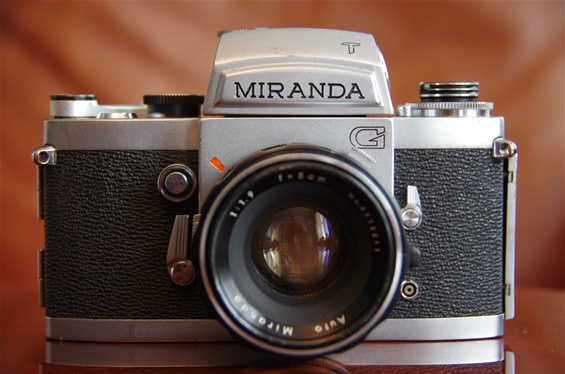 The G series in T version meant that the prism house could read the light through the lens (TTL), but with external readings, not coupled. Introduced in 1967. G cameras was top of the line, with interchangable focusing glass, and oversized lock up mirror.
Sn: 885875.
The G series in T version meant that the prism house could read the light through the lens (TTL), but with external readings, not coupled. Introduced in 1967. G cameras was top of the line, with interchangable focusing glass, and oversized lock up mirror.
Sn: 885875.
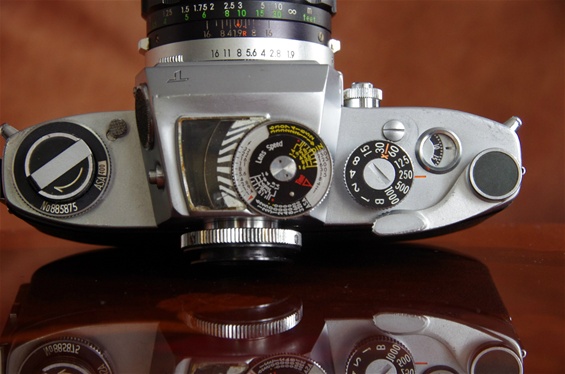 The T prism reading Through The Lens.
The T prism reading Through The Lens.
The Laborec series: 1965-1975:
1965: MIRAX LABOREC 1966: MIRAX LABOREC II 1970: MIRANDA LABOREC 1972: MIRANDA LABOREC Elektro D 1975: MIRANDA LABOREC III
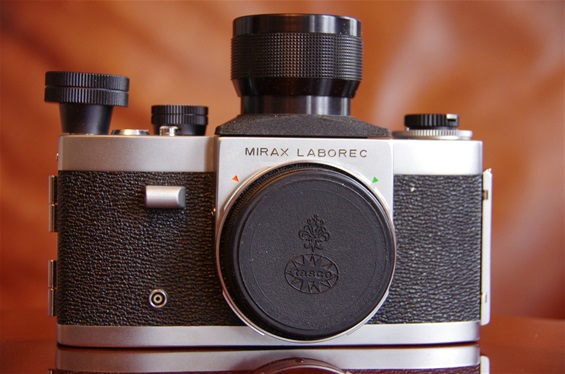 Miranda produced some cameras for scientific purposes, like this Mirax Laborec from 1965. The construction was very special, as one can see. One specialty was the mirror that was constructed to move slowly in order to soften any shocks and movements in the camera. Extremely rare!
Sn: 119642.
Miranda produced some cameras for scientific purposes, like this Mirax Laborec from 1965. The construction was very special, as one can see. One specialty was the mirror that was constructed to move slowly in order to soften any shocks and movements in the camera. Extremely rare!
Sn: 119642.
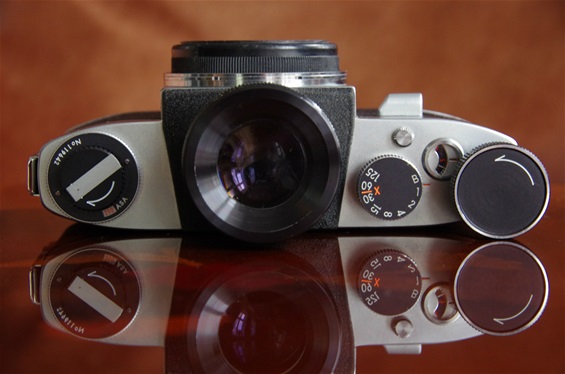 Constructed for tripod use, the Laborec could only be fired by a cable release.
Constructed for tripod use, the Laborec could only be fired by a cable release.
The Sensorex/Sensomat series: 1967-1976:
1967: SENSOREX
1970: SENSOREX C
1972: SENSOREX II 1971: SENSOREX EE 1976: EE-II 1969: SENSOMAT 1971: SENSOMAT RE 1975: RE-II
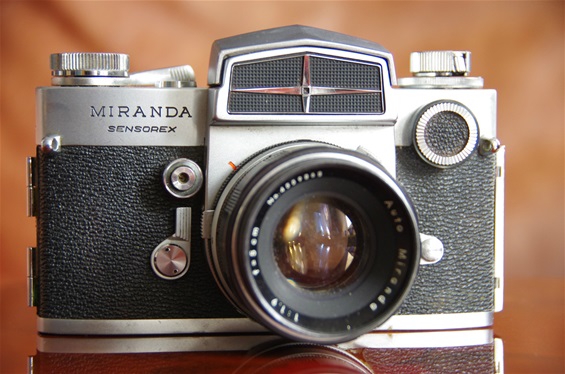 The Sensorex of 1967 introduced Mirandas first real TTL camera. It was a continuation of the Automex line introduced in 1960, and used the same prism. The Sensorex was developed further through model C in 1970 and model II in 1972, all within the same metering system.
The C model of 1970 added hinged back door, hot shoe on top, plus option for black body and 1,4 lens.
Sensorex II of '72 added 3200 ASA sensitivity, new prism, new design on winder arm, as on the EE model released some months before.
Sn. on this Sensorex: 708758.
The Sensorex of 1967 introduced Mirandas first real TTL camera. It was a continuation of the Automex line introduced in 1960, and used the same prism. The Sensorex was developed further through model C in 1970 and model II in 1972, all within the same metering system.
The C model of 1970 added hinged back door, hot shoe on top, plus option for black body and 1,4 lens.
Sensorex II of '72 added 3200 ASA sensitivity, new prism, new design on winder arm, as on the EE model released some months before.
Sn. on this Sensorex: 708758.
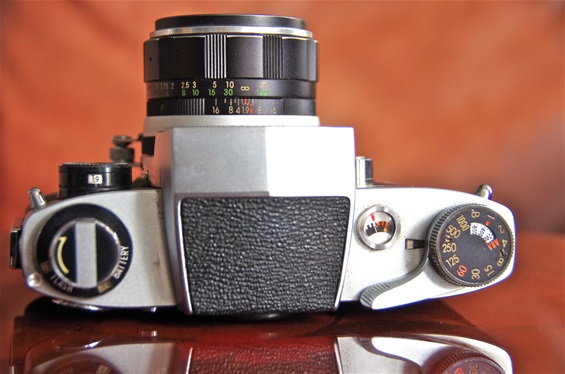 Winder, shutter dial and ASA setting in one piece. Neat! To the left, in front of rewinder, is a dial for setting the biggest aperture value according to actual lens. This was necessary for the meter system.
Winder, shutter dial and ASA setting in one piece. Neat! To the left, in front of rewinder, is a dial for setting the biggest aperture value according to actual lens. This was necessary for the meter system.
On front wall: dial to determine biggest opening. On top: rewind crank, handle for flash connection and battery on/off dial.
When mounting lenses, one had to pair the arm from the lens to the one on the camera. More or less like the Nikon system.
Prism house with release button and battery compartment further left.
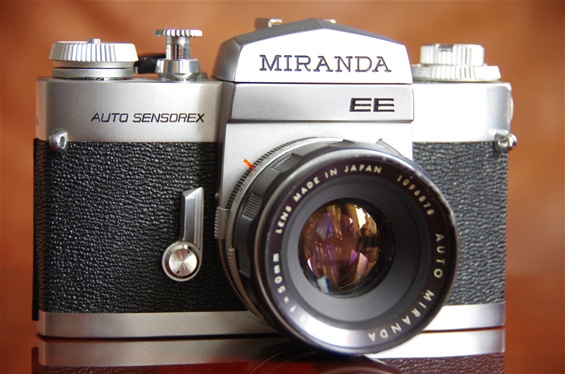 With the auto Sensorex EE of '71, Miranda introduced a fully automatic Electric Eye metering system. All connections to the diaphragm happened inside the camera, gone was the external connecting pin from the earlier models. The EE also introduced a spot/average metering choice.
Sn. 9125961.
With the auto Sensorex EE of '71, Miranda introduced a fully automatic Electric Eye metering system. All connections to the diaphragm happened inside the camera, gone was the external connecting pin from the earlier models. The EE also introduced a spot/average metering choice.
Sn. 9125961.
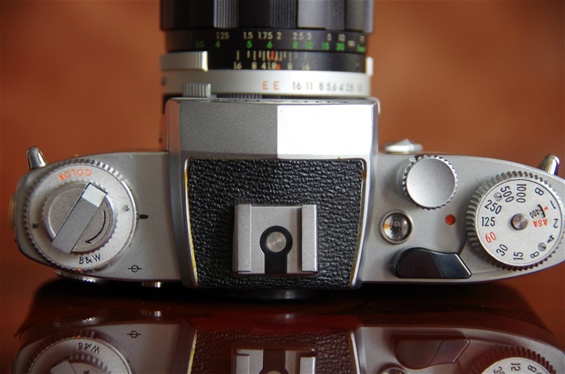 A bigger and quite more ergonomic release button is the most visible difference. But hidden on the left side is another feature. Like on the Sensorex II from '72, the EE had a new prism, coming with a fixed hot shoe for flash.
The last Sensorex, the EE II (no Sensorex name visible) added a new lens, the EC (E compact) with the same functions as the E lenses. It also introduced an extra window in the finder showing chosen shutter speed. The EE II was introduced '76, only months before the company collapsed.
A bigger and quite more ergonomic release button is the most visible difference. But hidden on the left side is another feature. Like on the Sensorex II from '72, the EE had a new prism, coming with a fixed hot shoe for flash.
The last Sensorex, the EE II (no Sensorex name visible) added a new lens, the EC (E compact) with the same functions as the E lenses. It also introduced an extra window in the finder showing chosen shutter speed. The EE II was introduced '76, only months before the company collapsed.
Under the rewind crank is a dial to switch between average or spot metering. Not many cameras had that at the time.
The new E lenses. No more external arm for aperture control.
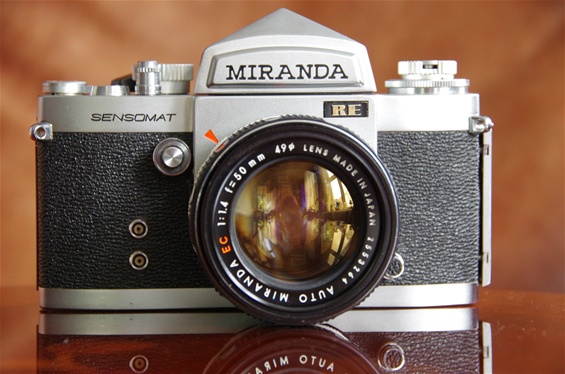 The Sensomat of 1969 was a budget model series of the Sensorex, something like the Nikkormat/Nikomat to the Nikon. This RE of 1971 had full TTL metering with internal automatic diaphragm. Sn: 6835398. The lens is an automatic EC Auto Miranda 50/1,4 with sn. 2553264. This lens came with the EC II, so it does not match this camera, but it could be used on earlier models with some restrictions. Size: 150x95x42mm. Weight: 675 g.
The last Sensomat was called RE II and was introduced in 1975.
The Sensomat of 1969 was a budget model series of the Sensorex, something like the Nikkormat/Nikomat to the Nikon. This RE of 1971 had full TTL metering with internal automatic diaphragm. Sn: 6835398. The lens is an automatic EC Auto Miranda 50/1,4 with sn. 2553264. This lens came with the EC II, so it does not match this camera, but it could be used on earlier models with some restrictions. Size: 150x95x42mm. Weight: 675 g.
The last Sensomat was called RE II and was introduced in 1975.
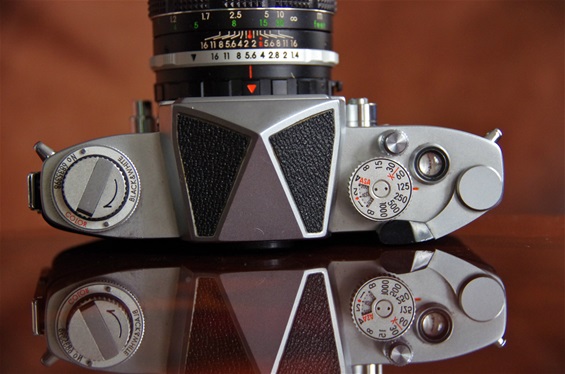 Top deck show no changes from the Sensomat of 1969, and basically like the F of 1963.
Top deck show no changes from the Sensomat of 1969, and basically like the F of 1963.
The dx-3: 1975-1976:
Together with the EE II and the SE II, the dx-3 was Mirandas last camera. The owner of Miranda camera Co., the American import/export company Allied Impex Corporation, struggled financially, and this last model did not give the sales that the company
needed. So, this PP SLR pioneer sadly had to give in. On December 10th 1976 Miranda was history. Don't mind about some models with Miranda label produced in the 80s, the MS-1, MS-2 and MS-3. They were produced by Cosina for the Dixon group, and had
nothing to do with the original Miranda company.
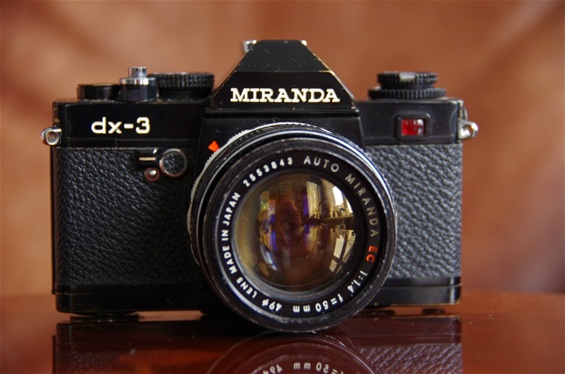 This was a new kind of camera from Miranda: smaller in size and electronic aperture automation. Size: 136x88x42mm. Weight: 562 grams. But it was not enough to take back the initiative, and sales was disappointing. Besides, the quality was not as it needed to be. This sample is among the few where the self timer handle is intact. It is pure plastic and very fragile.
Sn. 3933661.
This was a new kind of camera from Miranda: smaller in size and electronic aperture automation. Size: 136x88x42mm. Weight: 562 grams. But it was not enough to take back the initiative, and sales was disappointing. Besides, the quality was not as it needed to be. This sample is among the few where the self timer handle is intact. It is pure plastic and very fragile.
Sn. 3933661.
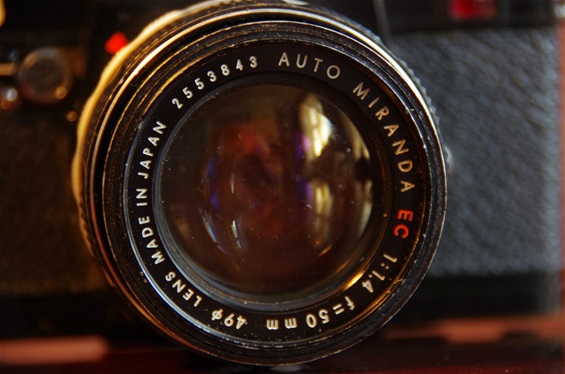 The lens was the same as for the RE 2 and EE 2 cameras.
Here is an Auto EC 50/1,4 with sn. 2553843.
The lens was the same as for the RE 2 and EE 2 cameras.
Here is an Auto EC 50/1,4 with sn. 2553843.
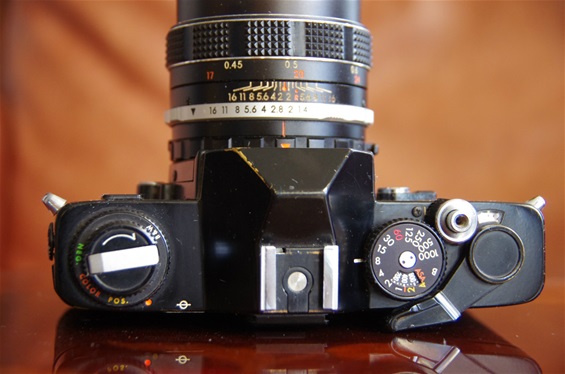 Traditional, easy to handle layout.
Traditional, easy to handle layout.
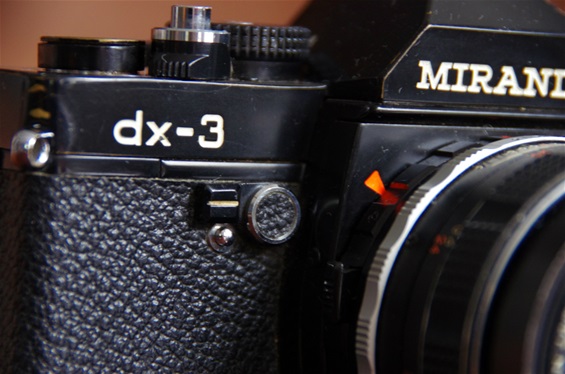 One of the very few self timer levers not broken.
One of the very few self timer levers not broken.
|
|
 |
|
|
|